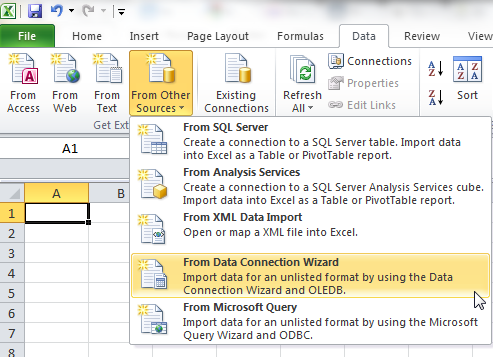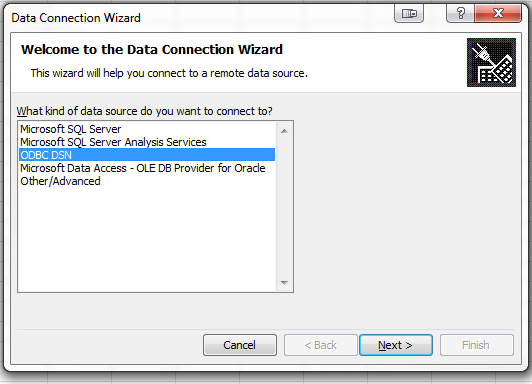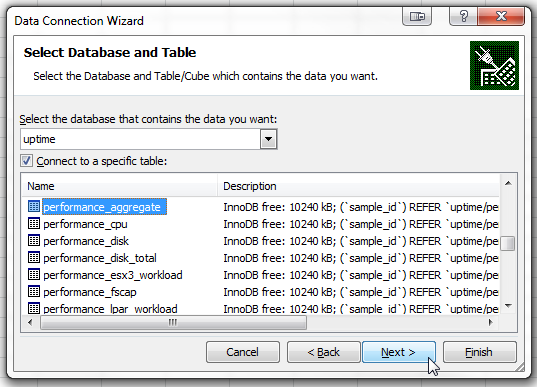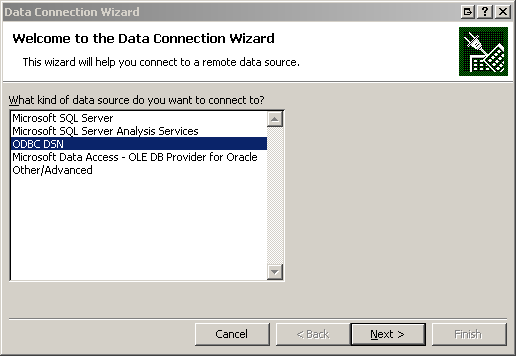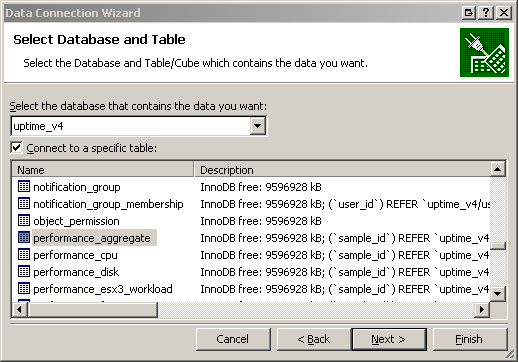...
If you have not already done so, install the MySQL ODBC driver and create a data source to access the up.time DataStore. This article assumes you have performed these steps. For more information, see the Connecting to the up.time DataStore via ODBC Knowledge Base article.
...
Retrieving up.time Data in Excel 2010: Creating a New Database Connection
...
- Start Microsoft Excel 2010.
- Open the Data Connection Wizard: click on Data on the menu bar, click on From Other Sources, then click From Data Connection Wizard.
The Data Connection Wizard appears: - Select ODBC DSN as the type of data source you want to use to make a connection, then click Next.
- In the next Wizard step, select the up.time ODBC data source, then click Next.
The name of the data source in the list is the name you gave the up.time DataStore when you created its profile in the ODBC Data Source Administrator Control Panel. - In the next step, select a database and specific table from the data source:
The database name you select is the name you gave to the up.time DataStore when you created its profile in the ODBC Data Source Administrator Control Panel. The database table you select depends on the type of up.time data you want to import into Excel (in this example, we are importing aggregate performance data). - In the final Wizard step, remember the Friendly Name assigned to this connection profile, then click Finish to save the database connection profile.
Note: Now that you have created an Office database connection (.odc) file for the up.time database and specified table, you will be able to use this existing connection to perform new database queries in future Excel sessions (on the Data tab, in the Get External Data group, click Existing Connections, then select the connection by clicking the Friendly Name). When you begin to work with data using an existing connection, Excel will prompt you with the Import Data dialog box, which you can use to modify your database query.
When you create a connection to the up.time database for the first time, you will always be prompted with the Import Data dialog box; this dialog box is described in the next section.
...
- Start Microsoft Excel 2007.
- Open the Data Connection Wizard: on the Data tab, in the Get External Data group, click From Other Sources, then click From Data Connection Wizard.
The Data Connection Wizard appears:
- Select ODBC DSN as the type of data source you want to use to make a connection, then click Next.
- In the next Wizard step, select the up.time ODBC data source, then click Next.
The name of the data source in the list is the name you gave the up.time DataStore when you created its profile in the ODBC Data Source Administrator Control Panel.
- In the next step, select a database and specific table from the data source:
The database name you select is the name you gave to the up.time DataStore when you created its profile in the ODBC Data Source Administrator Control Panel. The database table you select depends on the type of up.time data you want to import into Excel (in this example, we are importing aggregate performance data).
- In the final Wizard step, remember the Friendly Name assigned to this connection profile, then click Finish to save the database connection profile.
Note: Now that you have created an Office database connection (.odc) file for the up.time database and specified table, you will be able to use this existing connection to perform new database queries in future Excel sessions (on the Data tab, in the Get External Data group, click Existing Connections, then select the connection by clicking the Friendly Name). When you begin to work with data using an existing connection, Excel will prompt you with the Import Data dialog box, which you can use to modify your database query.
When you create a connection to the up.time database for the first time, you will always be prompted with the Import Data dialog box; this dialog box is described in the next section.
...
